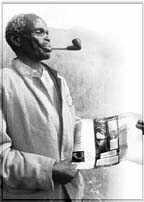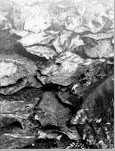 |
Jakob
Bandusya,
local plant resource
expert from Uganda,
holding People and Plants
brochure in which he is
pictured
(Photo:
AB Cunningham). |
|
Editorial
Traditional
ecological knowledge...
Biodiversity conservation...
Access to genetic resources...
Community development...
Intellectual property rights.
These are the keywords that spark
many debates on the role of local
people in the management and
conservation of the world’s
natural areas and biological
resources. Although this dialogue
is typically carried on in
universities, scholarly journals
and policy centers, the most
exciting inputs come from people
who are working in the field, and
whose efforts do not always
receive the publicity they
deserve.
How
can we ensure that innovative
developments in remote areas
reach the far corners of the
world? We hope that one avenue
will be this Handbook, produced
by People and Plants, a joint
initiative of WWF-International,
UNESCO and the Royal Botanic
Gardens, Kew.
|
| Our
main objective is the
democratization of knowledge:
ensuring that men and women of
all cultures, social ranks and
professions have access to
information. Information is
power, and is often hoarded by a
powerful few who perceive it as a
resource in short supply. We aim
to break such monopolies, sharing
advice among friends and
colleagues throughout the world
who are seeking to achieve sound
management of biological
resources while contributing to
biodiversity conservation and
community development. They have
taken on a task which is not
easy, particularly in areas where
requesting land and resource
rights is politically sensitive,
where raising the standard of
living implies a heavy impact on
plant and animal resources, or
where there is a conflict between
biodiversity conservation and the
needs of local people. A free and
direct flow of information
between colleagues can inspire
new approaches in field projects.
It can also keep politicians and
academics, who play a key role in
designing policies on access to
land and resources, in touch with
local realities.
Who is in our audience? We will
ensure that the Handbook reaches
the network of non-governmental
organizations, community
promoters, protected area
managers, project coordinators
a nd other field-oriented
people that we have developed
during the course of the People
and Plants Initiative. Getting
the Handbook into the hands of
policy-makers is another goal. We
ask our readers the favor of
passing this and future issues
along to any colleagues who would
like to join our network and have
access to the Handbook.
For our first issue, we present a
general introduction to sources
of information - international
programs, professional societies,
networks, resource centers,
journals and newsletters - which
may not be known to everyone who
receives the Handbook. In future
issues, we will address specific
subjects such as joint forest
management, community education,
ethics, research methodology,
extractivism and agroforestry
systems.
Each issue will begin with an
editorial - a concise overview of
the subject, including a
discussion of its relevance to
resource management, conservation
and development. Turn the page,
and you will find letters to the
editor and a table of contents,
followed by short descriptions of
organizations, networks,
publications and other sources of
information and inspiration.
Wherever possible, we add a
little flavor to the Handbook by
including excerpts, facts and
graphics from suitable sources.
In giving the addresses of key
contact persons for each item, we
hope to promote personal
communication between people who
are on similar paths of discovery
and experimentation. All issues
carry a viewpoints and issues
section that presents important
lessons to be drawn from the
subject at hand. Suggestions for
further reading and communication
are found in the multimedia
center, which highlights books,
publishing houses, Internet Web
sites and other media tips. The
plants scattered in photographs,
textures and backgrounds
throughout each issue are
described in the ethnobotanical
portraits section, which also
contains short notes on projects
and profiles of colleagues. On
the last page you will find
acknowledgements and information
on future issues of the Handbook.
Each issue will be accompanied by
a one page supplement that
contains a cumulative index, list
of acronyms and register of the
contributors who are identified
by their initials in the
Handbook.
Whereas more and more
publications are being brought to
you in living color and unique
formats, we are bucking the trend
by printing in black and white,
and using standard-sized paper.
This allows us to produce the
Handbook economically, and you to
reproduce it by photocopying. We
hope to show that seeing
the world in shades of gray can
be just as accurate and beautiful
as all the colors of the rainbow.
Although the voices of both
American and British speakers of
English (and many other
nationalities) are heard on the
pages of the Handbook, we have
opted for American English
spellings and usage. But you will
note that we have left British
spellings in titles and excerpts,
just as we found them.
We welcome your input on the
design, content and scope of the
People and Plants Handbook. We
cannot include all relevant
information in each issue, but we
would like to request that you
keep us informed of new
developments and organizations
that we may have missed. And
speaking of keeping in touch, our
addresses, fax, telephones and
e-mail are listed on the facing
page. We look forward to hearing
from you.
-
Gary J. Martin, Handbook editor
Back
|
 |
| Sun-drying
of sal leaves (Shorea
robusta,
Dipterocarpaceae) in West
Bengal, India. |
|
Leaves
of paper: Letters to the Editor
The
People and Plants Handbook is
like a baton in a relay race. It
is to be passed from one person
to another, ensuring that we
share our knowledge and contacts
with others. Although we try to
provide a range of information in
short articles and notes in the
main body of the Handbook, we
cannot hope to mention all the
organizations, services and data
sources related to our interests.
Our choice of what to include is
biased inevitably by our existing
knowledge and networks. The
letters to the editor section
provides a space for our
colleagues to talk about their
own work and viewpoints,
attracting correspondents of like
mind and expanding the breadth of
information that we
present.
|
| Why
call the letters section
‘leaves of paper’? In
part, because we like the
botanical metaphor, used in many
languages, of considering a sheet
of paper as synonymous with a
leaf (for example, feuilles in
French and hojas in Spanish). And
also because it gives us yet
another opportunity to draw
attention - on the
‘leaves’ of the
Handbook - to the diverse uses of
plants around the world,
including the sal leaves pictured
to the right.
Over the last year, as we began
preparing the first issues of the
Handbook, we heard from many
individuals who offered their
perspectives and a helping hand.
As a way of launching the letters
to the editor section, we are
printing a few of these messages.
As with other items, we give the
full contact of our
correspondents (with their
permission) to encourage as much
direct communication as possible
between colleagues. In the
future, we will print additional
letters from our readers,
particularly those who provide
insights on subjects covered in
back, current and coming issues
(see page 24). To help us stay in
touch and build our Handbook
networking database, please
remember to send your complete
address, phone, fax and e-mail,
and a brief description of your
current projects. Don’t
forget to include the country and
city codes for all telephone
numbers. We take the liberty to
edit the letters for the sake of
clarity and brevity, but seek to
leave the style, content,
enthusiasm or criticism intact.
Feel free to send us a baton, so
that we may pass it along to
others. -
GJM
|
1 August
1995
Greetings
from WWF-India. Mr. Samar Singh has
passed on to me papers related to the
People and Plants Initiative. Having
gone through some of the documents, I
find that this initiative would be a
very useful concept in relation to
WWF-India’s programme
activities.
WWF-India’s
Community Biodiversity Conservation
Movement (CBCM) programme was
launched in 1989 essentially to
involve local communities in the
conservation of biological diversity.
It provides for small, intense and
clearly focused projects by field
based NGOs, institutions or other
bodies having the capacity to create
the conditions for enhancing
community-based conservation of
biodiversity. We have undertaken
several projects in the past on wild
plant conservation and we have
supported many grassroots
organizations in various regions of
the country to promote
knowledge-based studies on medicinal
plants. We have recently brought out
a small booklet on CBCM programme
activities and case
studies.
I take
this opportunity to establish a link
with your programme activities and
trust that we may be able to interact
more frequently in the future on
possible areas of cooperation. I
shall be glad to be on your mailing
list and look forward to receiving a
copy of the People and Plants
Handbook.
Prakash
Rao, Senior Program Officer, CBCM, WWF
India, P.O.
Box 3058, 172-B, Lodi Estate, Max
Mueller Marg, New Delhi - 110 003,
India; Tel.
+91.11.4627586, Fax +91.11.4626837 .
10 August
1995
I am
very interested in the work of People
and Plants. We have also done a lot
of work on these aspects, but the
results are all in Chinese. We have
established a non-governmental
organization, The Natural
Conservation Research Centre of East
Asia, in Zhuang Autonomous Region of
Guangxi. The Centre can arrange these
kinds of research
activities.
Wang
Xianpu, Institute of Botany, The Chinese
Academy of Sciences, 141 Xizhimenwai Da
Jie, Beijing 100044, China .
20
September 1995
We
learned about your People and Plants
Handbook through the newsletter
Connect. We are a group working with
the indigenous tribal mass in the
Eastern Himalayan foothills and the
flood-affected plains of river
Bramhaputra. We are also involved in
biodiversity conservation through
community participation. I would
therefore like to know as to how we
can help you in your
efforts.
Sathyasree,
Project Coordinator, Rural Volunteers
Centre, Aakajan
787 059, Silapathar, Dhemaji, Assam,
India .
5 April
1995
Your
idea for the Handbook sounds like a
good one and includes many of the
areas which need greater illumination
in a broad, accessible sense. You ask
for organizations and programs. I
have a suspicion that the best of
what goes on in terms of community
development and plants is done by
people who do not publish and who do
not belong to high profile
organizations. That in backyards all
over the world, folks are figuring
out solutions and saving their
personally favorite plants. It may be
interesting if, besides programs, you
offer case studies, nitty-gritty
examples - how are people working
with plants and people, and what is
working?
Patricia
Shanley, 151 Grant Street, Berkeley
Heights, NJ 07922, USA; Fax
+1.908.7715524 .
3 May
1995
It is
vitally important that the Handbook
is not too Eurocentric. In this part
of the world ethnobotany, economic
botany, pharmaceuticals, trade
agreements, etc. are not always
favoured words, and there are some
very fundamental issues on ownership
and rights which cannot be glossed
over. This comment may seem a hard
line but the issues are very real for
many Pacific people, and have the
potential to topple governments.
David
Given, David Given & Associates, 101
Jeffreys Road, Christchurch, New Zealand;
Tel./Fax +64.3.3516069, e-mail : givend@lincoln.ac.nz
Back
|